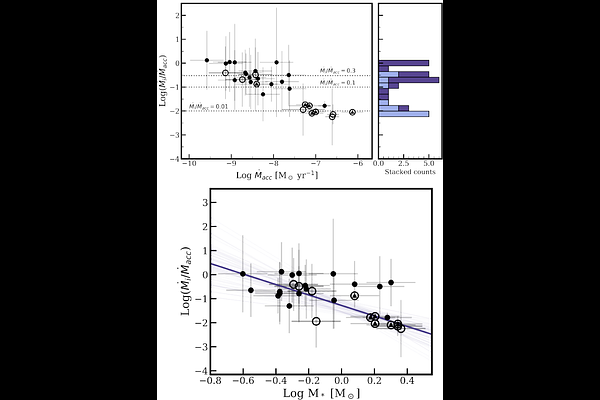A correlation between accretion and outflow rates for Class II Young Stellar Objects with full and transition disks

A correlation between accretion and outflow rates for Class II Young Stellar Objects with full and transition disks
A. A. Rota, N. van der Marel, A. Garufi, C. Carrasco-González, E. Macias, I. Pascucci, A. Sellek, L. Testi, A. Isella, S. Facchini
AbstractMagnetothermal (MHD) winds and jets originate in a wide range of regions of protoplanetary disks (1-30 au) and are thought to be the primary mechanisms driving accretion onto the central star. One indirect signature of these processes is the free-free emission from ionized gas close to the star. We analyze a sample of 31 Class II disks: 18 full disks (FD) and 13 transition disks (TD). All sources show evidence of excess free-free emission over the contribution of the thermal dust. We investigate the origin of this emission and whether it is associated with other observables. We first analyzed a sample of objects in Taurus, exploring correlations with the properties of the central star, the disk, and other disk-wind tracers. We compared our findings with a sample of TD for which free-free emission was shown to be likely associated with an MHD-wind/jet. We found no correlation between the detected free-free emission and either the X-ray or the [OI]6300A line properties. We found a strong correlation between the ionized mass loss rate, as inferred from the free-free emission, and the accretion rate, suggesting that free-free emission in FD is associated with an MHD-wind/jet. The detected free-free emission in both TD and FD is likely similarly associated with an ionized gas close to the star from an MHD-wind/jet. The free-free emission detected in TD shows hints of shallower correlations with accretion properties than in FD. Whereas the efficiency in transforming accretion into outflow might differ in TD and FD, considering the correlations between free-free emission and accretion properties, this difference could simply result from a bias toward strong accretors in the TD sample. Therefore, observations of a more complete and uniform sample are necessary to determine whether this change in correlations holds only for strong accretors or for TD in general.